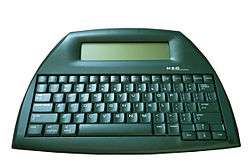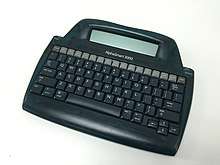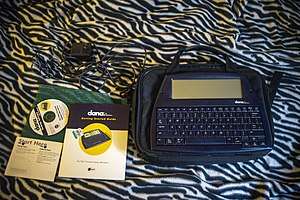AlphaSmart
The AlphaSmart was a brand of portable, battery powered, word-processing keyboards manufactured by NEO Direct, Inc. (formerly Renaissance Learning, Inc, formerly AlphaSmart, Inc., formerly Intelligent Peripheral Devices, Inc.). Originally released in 1993, the first AlphaSmart models were intended for writing on-the-go and could be plugged into a computer to transfer saved written text. The units' portability and long battery life made them valuable to journalists, writers, and students. Later models expanded functionality by spell-checking, running applications, and accessing wireless printers.
The last model, Neo 2, was released in 2007, and production was discontinued by the company in late September 2013, although the company still offers support and software to existing users.[1]

Background
The AlphaSmart was a keyboarding device that enabled a person to work on the go, much like a laptop computer, but it was strictly for word processing, as it functioned essentially like a simple digital typewriter. The Dana (one of the last devices made by AlphaSmart) was an exception, as this device also ran Palm OS applications. Since the AlphaSmart, Dana, and NEO were specialized for limited purposes, they were generally much cheaper than a standard laptop computer. All of these devices were meant to be plugged into an ADB, PS/2, or USB port for transferring the written text into a computer's word processing document for further editing (such as indentation and font preference) or printing if so desired.
The AlphaSmart saved every keystroke directly to the machine's RAM, which was maintained by a battery backup even when powered down. AlphaSmarts could transfer data either by a special program that communicated with the AlphaSmart or by the simpler method of transmitting the keystrokes of the written text as if it were the computer's keyboard. When not transferring text, the AlphaSmart could be used as a standard keyboard.
AlphaSmarts were very popular in schools for their affordability and durability. Elementary schools and high schools used them; and they were particularly popular among special education departments for use by students with graphomotor challenges.
The machines were also popular among journalists and writers, who found them easy to carry and appreciated the full-size keyboard and long battery life.[2]
Company
Intelligent Peripheral Devices, Inc.[2] was founded in 1992 by two previous Apple Computer engineers, Ketan Kothari[3] and Joe Barrus,[4][5] with the mission to "develop and market affordable, portable personal learning solutions for the classroom" and to "deliver affordable, lightweight, rugged portable computing devices that are expandable, easy to use and manage, and provide exceptional battery life." Shortly after its founding they were joined by Ketan's brother Manish.[6][7] Later, they changed the name of the company to AlphaSmart, Inc.[8][9][10]
Barrus and Kothari also hold a US patent on a "portable keyboard computer", applied for in 1992 and granted in 1995.[11]
AlphaSmart, Inc. completed its initial public offering (IPO) on the NASDAQ on February 6, 2004 and started trading under the symbol ALSM. In June 2005, it was acquired by Renaissance Learning (NASDAQ: RLRN). The name changed again in the Spring of 2009, this time to NEO Direct, Inc. They went on to release the Neo2[12] and 2Know Responder[13] hardware products.
AlphaSmart products
AlphaSmart
The original AlphaSmart computer companion was shipped in August 1993, and worked only with Apple Macintosh and Apple IIGS computers, plugging into the Apple Desktop Bus (ADB) port. This model provided customers with 16 "pages" of memory (32,000 bytes) for eight separate files (2 pages per file), that were accessed by pressing the corresponding function key. The AlphaSmart took on the aesthetics of the computer it was intended to be partnered with — it had a boxy, durable beige plastic case like the IIGS and Macintoshes of that era. It had a four-line LCD character display similar to what one would find on some appliances. Each character was displayed in its own LCD "box," making the point size and font type fixed. The AlphaSmart could not display graphics, except for ASCII art. It ran on 2 AA batteries and could be used for days at a time due to a power-saving technique, that effectively allowed it to "sleep" in between keystrokes. There was a rechargeable nickel-cadmium battery (NiCad) pack add-on that a customer could purchase separately.
The early AlphaSmart models included a couple of jokes, including a reference to The Hitchhiker's Guide to the Galaxy. If, while using the calculator, the answer is 42, the words "The answer to Life, the Universe, and Everything" appear. Or, if the input was 1+1, the calculator would say, "That's too easy."
AlphaSmart Pro

In February 1995, the AlphaSmart Pro was launched. This looked almost identical to the original but had a PS/2 port as well as an ADB port, making it compatible with both Windows PCs, as well as the Apple IIGS and Macintoshes. Second, the Pro had a "find" feature to search stored text. Third, the AlphaSmart Pro was able to receive text from a computer through "Get Utility" software installed on a Mac or Windows PC. Lastly, it included a password feature for securing content. The Pro model was able to store up to 64 pages of text (128,000 bytes), holding 16 pages in the first file, 8 pages in files two through five, 6 in files six & seven, and 4 pages on file number eight. The original rechargeable NiCad battery pack could also be used in the Pro model.
AlphaSmart 2000
In October 1997, AlphaSmart introduced the third generation of the AlphaSmart family, the AlphaSmart 2000. Along with a more ergonomic design, the case of the AlphaSmart 2000 was curvy and blue. New features added were spell-checking, direct printing (allowing a user to plug into a printer directly, bypassing a computer), auto-off power save, and a keyboarding timer. A year later, the company added infrared capability to the 2000, enabling users to transfer text to a computer or another AlphaSmart without a cable. This model needed 3 AA batteries, but could still use the original rechargeable NiCd battery pack. Like the AlphaSmart Pro, it had a 128 kB memory.
AlphaSmart 3000

In January 2000, the AlphaSmart 3000 was released. The 3000 used the same chassis as the AlphaSmart 2000, but it was now encased in translucent bondi-blue plastic, matching Apple Computer's first generation iMac. This was meant to be a visual indication that the AlphaSmart 3000 was a USB native device, as many other USB devices were patterned using the iMac's design in the same way.
Designers removed the ADB and PS/2 ports, replacing them with a USB port and a mini-DIN-8 serial port that allowed users to plug the AlphaSmart directly into a printer. Also new was the SmartApplet architecture that was capable of extending the simple functionality of an AlphaSmart with the inclusion of SmartApplets—miniature software applications that extend the AlphaSmart's functionality to give it features beyond basic word processing. For example, it included a simple 5-function calculator. Additionally, the battery life and memory were increased (although it still ran on 3 AA batteries), and cut/copy/paste functions were introduced. The original rechargeable NiCd battery pack was not compatible with this model. Instead, it used a new optional nickel metal hydride battery (NiMH) pack that lasted longer and eliminated the memory effect of NiCd batteries. The AlphaSmart 3000 had the customary 8 files, each with a capacity of 12.5 pages (about 25 kilobytes), for a total of 100 pages altogether.
AlphaSmart announced the discontinuation of the AlphaSmart on April 30, 2006.[14]
Dana
 | |
| Manufacturer | AlphaSmart |
|---|---|
| Type | Portable computer |
| Operating system | Palm OS 4.1.2 |
| CPU | Motorola Dragonball VZ @ 33 MHz |
| Storage | 8 MiB (Dana (First Revision) or 16 MiB (Dana (Second Revision) and Dana Wireless[15]) internal RAM |
| Removable storage | two SD card slots |
| Display | 560x160 pixels,4 (Dana (First revision)) and 16 (Dana (Second Revision) and Dana Wireless) shade greyscale |
| Input | full-sized keyboardTouchscreen |
| Touchpad | Entire screen |
| Connectivity | Infrared, USB master, USB slave, Dana Wireless adds WiFi, SDIO |
| Power | 3.6V NiMH battery pack or3 AA batteries ormains power adapter |
| Dimensions | 1.9 in × 12.4 in × 9.3 in (4.8 cm × 31.5 cm × 23.6 cm) |
| Mass | 2.0 lb (0.91 kg) |
| Predecessor | AlphaSmart 3000 |
| Successor | Neo |
In June 2002,[16] AlphaSmart released the Dana product which was a radical departure from their standard product line. Similar to Apple Computer's Newton eMate 300 (a laptop running the Newton PDA operating system), the Dana, FCC ID KV2DANA001, was a fully fledged Palm OS device complete with a touch-screen, allowing a user to write directly on the screen via Graffiti in addition to typing on the built-in, full-size keyboard. The Dana's screen had a backlight and was capable of displaying complex graphics (though only in 4 bit grayscale), unlike the original AlphaSmart line. It had 8 mebibyte (MiB) of storage and two expansion slots for cards in Secure Digital (SD) or Multimedia Card formats. It was compatible with nearly every Palm OS application, and some Palm apps could take advantage of the Dana's extra-wide screen, which was 3.5 times the norm (560 x 160 pixels).
The Dana's primary software was the built-in Alphawrite word processor. This is a licensed version of Wordsmith for Palm OS by Blue Nomad,[17] customized for the Dana's wider screen. Up to eight Alphawrite documents could be resident at one time, each instantly accessible via the Dana's eight function keys. It was a simple matter to also switch between the Alphawrite documents and any of the four standing built-in application native to Palm OS (Memo Pad, Datebook, Todo, Address Book). Larger size fonts could be selected from within Alphawrite to compensate for the low-contrast screen display's being somewhat difficult to read.
The screen could be used in either landscape mode or portrait mode, though there is no auto-detection of how the Dana is positioned; the user had to tap a menu selection to choose the mode.
The screen was taller than that of the original AlphaSmart products, and the Dana's casing was made from opaque dark-blue plastic—a change from the iMac-esque clear blue of the AlphaSmart 3000. It used either a Ni-MH rechargeable battery or 3 AA batteries for up to 25 hours of usage.
Danas produced near the end of its production run had their OS software modified because many users complained that their Danas were frequently turning themselves on when carried in a container, such as a backpack, depleting the battery charge. This was because the on-off switch was getting depressed and switching the device on. Version 1.5 of the Dana OS provided a way to require both the Enter and On/Off keys to power it up, making it less likely that both keys would be depressed accidentally. This was accessed through the system Keyboard App.
The Dana had an IRDA compatible infrared port for transferring documents and files. This was a convenient way to back up files for those who had access to multiple Danas.
Dana Wireless
One year later, in 2003,[18] AlphaSmart added the Dana Wireless model (FCC ID KV2DANA002) which added built-in Wi-Fi connectivity for internet use & interaction with other Danas, doubled the RAM capacity from 8 MiB to 16 MiB, doubled flash ROM from 4 MiB to 8 MiB, and added SDIO support to the SD card slots. It used 3 AA batteries (standard or Ni-MH or Ni-Cad) for up to 20 hours of usage.[19][20]
Neo
The Neo model was introduced in August 2004 and could hold more than 200 pages of text. Its LCD was 50% larger than the AlphaSmart 3000's display. Unlike the 3000, it didn't use fixed blocks for each character and therefore, could display different font/point sizes, along with simple graphics. The Neo also ran a newer operating system that allowed for modular control of SmartApplets and a new version of AlphaWord (the word processing SmartApplet), which allowed dynamic file resizing. The Neo's chassis was a dark opaque shade of green with its form factor based on the Dana. The Neo also used the same class of CPU as the Dana. It used the same optional NiMH battery pack as the AlphaSmart Dana. Initially, the Neo had several software bugs, such as a hard-to-see cursor and a text-stacking file corruption problem.
In 2007, the Neo 2 added several minor upgrades to the original Neo and was the first unit released after AlphaSmart was acquired by Renaissance Learning.[21][22][23] It added quiz functionality, using the 2Know! Toolbar, which was developed for the 2Know! Classroom Response System. Teachers could create, distribute, and score quizzes using the Neo 2. Neo 2 could also access Accelerated Reader quizzes and allow students to use network printers, when using the Renaissance Receiver accessory.[24]
Both the Neo and Neo 2 were discontinued by Renaissance Learning in late September 2013, although the company still offers support and software to existing users as of March 2014.[1]
References
- "NEO Direct - Perfect for All Writing Needs". NEO Direct, Inc. Archived from the original on 2013-11-14. Retrieved 8 June 2017.
We have reached the end of our NEO 2 inventory, and we will no longer be producing any additional units — but this isn’t goodbye.
- "AlphaSmart 2000, of Interest to Writers". Chin Chet Mooi.
- James Sloan. AlphaSmart - an Education Case Study
- "Outstanding Alumnus Award for 2009 - ee@byu 2010" (PDF). Archived from the original (PDF) on 2016-05-11. Retrieved 2017-06-09.
- Seba, Tony (1 September 2006). "Winners Take All - The 9 Fundamental Rules of High Tech Strategy". Lulu.com. Retrieved 9 June 2017 – via Google Books.
- Jeremy Weisz (4 December 2014). "Manish Kothari Interview". inspiredinsider.com. Retrieved 9 June 2017.
- 4 December 2014
- "AlphaSmart". www.lawinsider.com. Retrieved 9 June 2017.
- "AlphaSmart: A History of One of Ed-Tech's Favorite (Drop-Kickable) Writing Tools". Hack Education. 25 July 2015. Retrieved 9 June 2017.
- "AlphaSmart - Richard's Notes". richardsnotes.org. Retrieved 9 June 2017.
- "US Patent". google.com. Retrieved 9 June 2017.
- "NEO Download Center - Software for NEO 1 and NEO 2 Devices". Archived from the original on 2012-08-25.
- "2Know! Classroom Response System - overview". Renaissance Learning.
- "AlphaSmart.com". alphasmart.com. Archived from the original on 2005-03-24. Retrieved 9 June 2017.
- Cohen, Peter (17 August 2003). "AlphaSmart updates Dana for back-to-school season". Macworld.
- "AlphaSmart Dana Palm OS Laptop Available Now". www.palminfocenter.com. Retrieved 2019-08-03.
- "The WordSmith Word Processor for the Palm OS". danbricklin.com. Retrieved 9 June 2017.
- Flegal, Matt (2003-09-09). "AlphaSmart Announces Availability of Dana Wireless; Affordable Palm OS Laptop Alternative Now Offers Built-in Wi-Fi Connectivity" (Press release). PRNewswire. Retrieved 2014-04-15.
- Fadhley, Mohd Nazley (2003-12-22). "AlphaSmart Dana Wireless". PalmX.org. Archived from the original on 2014-04-08. Retrieved 8 April 2014.
- Binks, Kate (2003-08-13). "New Version of Dana by AlphaSmart Introduced" (Press release). PR Newswire. Retrieved 2014-04-15.
- https://www.engadget.com/2007/06/25/renaissance-learning-intros-neo-2-laptop/
- "RENAISSANCE LEARNING, INC". www.sec.gov. Retrieved 9 June 2017.
- "Form 8-K". www.sec.gov. Retrieved 9 June 2017.
- "AlphaSmart.com". alphasmart.com. Archived from the original on 2007-10-05. Retrieved 9 June 2017.